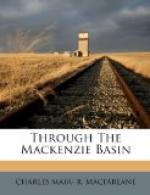rich burnt umber in the stream, and when blown upon
by the wind turns its sparkling facets to the sun like
the smile upon the cheek of a brunette. Its upward
course is like a continuous letter S with occasional
S’s side by side, so that a point can be crossed
on foot in a few minutes which would cost much time
to go around. Its proper name, too, is not to
be found in the atlases, either English or French.
There it is called the Lesser Slave River, but in
the classic Cree its name is Iyaghchi Eennu Sepe,
or the River of the Blackfeet, literally the “River
of the Strange People.” The lake itself
bears the same name, and even now is never called Slave
Lake by the Indians in their own tongue. This
fact, to my mind, casts additional light upon an obscure
prehistoric question, namely, the migration of the
great Algic, or Algonquin, race. Its early home
was, perhaps, in the far south, or south-west, whence
it migrated around the Gulf of Florida, and eastward
along the Atlantic coast, spreading up its bays and
inlets, and along its great tributary rivers, finally
penetrating by the Upper Ottawa to James’s,
and ultimately to the shores of Hudson Bay. I
know there is strong adverse opinion as to the starting-point
of this migration, and I only offer my own as a suggestion
based upon the facts stated, and as, therefore, worthy
of consideration. Sir Alexander Mackenzie speaks
of the Blackfeet “travelling north-westward,”
and that the Crees were “invaders of the Saskatchewan
from the eastward.” Indeed, he says the
latter were called by the Hudson’s Bay Company’s
officers at York Factory “their home-guards.”
One thing seems certain,
viz., that the Crees
got their firearms from the English at Hudson Bay
in the 17th century. Thence that great tribe,
called by themselves the Naheowuk, but by the Ojibway
Saulteaux the Kinistineaux, and by the voyageurs Christineaux,
or, more commonly, the Crees—a word derived,
some think, from the first syllable of the latter
name, or perhaps from the French
crier, to
shout—descended upon the Blackfeet, who
probably at that time occupied this region, and undoubtedly
the Saskatchewan, and drove them south along a line
stretching to the Rocky Mountains.
The tradition of this expulsion is still extant, as
also of the great raids made by the Blackfeet and
their kindred in times past into their ancient domain.
I remember visiting, with my old friend Attakacoop—Star-Blanket—the
deceased Cree chief, twenty years ago, the triumphal
pile of red deer horns raised by the Blackfeet north
of Shell River, a tributary of the North Saskatchewan.
It is called by the Crees Ooskunaka Assustakee, and
the chief described its great size in former days,
and the tradition of its origin as told to him in
his boyhood. Be all this as it may, and this
is not the place to pursue the inquiry, the stream
in question is, to the Crees who live upon it, not
the River of the Slaves, but the “River of the
Blackfeet.” How it came by its white name




